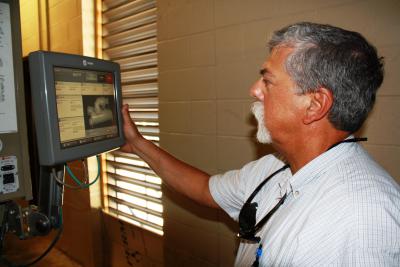Energy Efficiency Initiative Results in Savings of Approximately $2 Million
Wed, 08/24/2011 - 10:25am | By: David Tisdale

Through state-of-the-art technology and smart energy use, The University of Southern Mississippi has cut energy consumption costs on its Hattiesburg campus by nearly $2 million in the past year.
The savings are the result of an initiative by the Southern Miss Physical Plant to further maximize energy efficiency and reduce utility expenditures, keeping with one of the university's four strategic priorities - healthy minds, bodies and campuses, said Physical Plant Director Dr. Chris Crenshaw.
“In the past three years, we've made a dedicated effort to impact utility consumption on campus,” said Crenshaw, who noted that $8 million is budgeted annually for utility expenses at the university. “The result is significant savings as we continue to solidify ourselves as a role model for energy efficiency and environmental responsibility.”
Facilities across campus, including those designated for academics, athletics, residence life and dining were assessed at the beginning of the process to determine amounts of energy used, cost and the energy-use infrastructure in each building. The three-phase plan began with the assessment, followed by the implementation of new technology and energy use adjustments and concluding with an outcome analysis.
Crenshaw emphasized that in addition to this most recent initiative, the university continually reviews utility data, targets “hot” spots (high-energy consumption areas of campus) and makes adjustments that have minimal impact on building occupants and materials.
Highlights of the university's recent energy efficiency efforts include:
· Installation in several campus facilities of new, state-of-the-art energy meters to improve tracking of energy consumption
· Installation of Variable Frequency Drives (VFDs) that adjust energy use in buildings based on demand
· Installation of Energy Management Systems (EMS) that adjust energy settings on nights and weekends when some buildings are unoccupied
· Installation of new energy efficient boilers
An example of the progress made is the 20 percent drop in electricity use in the Chain Technology Building, and Crenshaw said he's received positive feedback from its occupants.
“With these improvements, which also impact air conditioning, temperatures in these buildings are more stable, consistent and comfortable than in recent years.”
The improvements also enhance the college's research environment, said Lynn Landrum, director of science safety for the university. “I'm pleased the Physical Plant is taking on this initiative,” he said. “To meet our goal of being a premier research university, our work here in the college has to be conducted in high quality, environmentally efficient laboratory settings so that they (faculty and students) can do the type of research we expect of them.”
Vigilance on the part of students, faculty and staff in making more efficient energy use choices also drives costs down. Making sure lights are turned off in empty rooms, powering down computers after use and taking advantage of outdoor light through windows are among the many simple steps that make a difference, Crenshaw said.
“We (Physical Plant) have a team of professionals dedicated to monitoring consumption and implementing savings strategies, and they're doing a great job,” he said. “In addition, members of the campus community aremore cognizant than ever of what they can do to help us meet energy efficiency goals. It takes a team effort, and that's what we're seeing.”
The next phase in the university's plans to save on utility costs is a $2 million energy retrofit program through the state's Bureau of Buildings. For the last nine months, on-site reviews of almost every piece of equipment in targeted areas of campus contributed to the development of an energy use strategy.
Besides Chain Technology, other buildings slated for energy efficiency upgrades and adjustments include Owings-McQuagge Hall; Fritzche-Gibbs Hall; Joseph Greene Hall; George Hurst; Johnson Science Tower; Forrest County Hall; College Hall; Stout Hall; Bennett Auditorium; McLemore Hall; Southern Hall; Kennard-Washington Hall; Aubrey K. Lucas Administration Building; and the Polymer Science Research Center.
“Weapplaud the work of the Physical Plant to reduce energy costs and to increase the efficiency of our facilities,” said Dr. Ann Blackwell, dean of the College of Education and Psychology which is located in Owings-McQuagge Hall.
Another campus-wide energy efficiency project to be supported by the Bureau of Buildings will see $750,000 in upgrades in the near future to infrastructure impacting electricity consumption. In addition, Cook Library will see the installation of energy efficient lighting equipment with an estimated payback period of just 18 months.
“It's exciting to see the savings resulting from the work we're doing,” Crenshaw said. “Going forward, we'll continue implementing new energy efficiency technology and strategies as they're developed.”